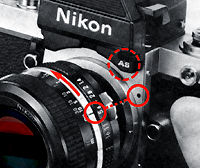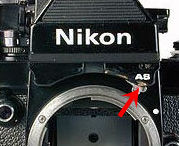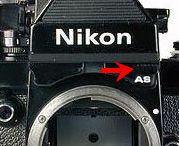Cont...
•
When interchanging
lenses, finders, etc., your camera is susceptible to the entry of dust or other contaminants.
It is a good idea to clean moving body parts frequently to prevent the buildup of
dust; here, a lens brush and blower will come in very handy. When blowing out the
interior of the camera, however, avoid contact with the shutter curtains, as they
are easily damaged. Also, wipe the outer body surfaces using a silicone-impregnated
cleaning cloth to remove fingerprints, etc. quickly and easily. (Note that a silicone
impregnated cleaning cloth should never be used to clean the lens surfaces.)
•
When exposed to sudden
temperature changes or high humidity, condensation may form on the lens surfaces.
After using in these
situations, always dry the camera thoroughly (and slowly) at room temperature and,
then, store in a cool, dry location. Remember that failure to dry out the camera
may result in the growth of fungus on lens surfaces—a condition that will render
your camera useless.
•
Should your camera
be accidentally dropped on the floor or in water, take it to your dealer immediately
for servicing. Thorough servicing can be guaranteed only at an authorized dealer.
•
Always store the camera
in an ever-ready case or compartment case when not in use. And be sure that the lens
cap is attached to the lens. Do not leave film in the camera for a long period of
time, and never store the camera with the shutter or self-timer cocked.
•
Never lubricate any
part of the camera. Lubrication should be left to an authorized service center. Prior
to a holiday trip or important shooting assignment, test your camera (including changing
batteries, if necessary) for proper operation.
•
Observe normal battery
handling procedures for maximum performance at all times. Be sure to: Clean batteries
periodically (wiping with a rough cloth will remove residues that might otherwise
impede performance); install batteries properly, checking for proper polarity; remove
batteries when not using the equipment for an extended period; change weak batteries
promptly to prevent leakage within the camera; store unused batteries properly (in
a cool, dry location) to maximize service life; dispose of batteries properly (do
not burn); and keep out of the reach of children. For details regarding battery performance,
refer to the original manufacturer.
Lens
Changing
One of the biggest reason why one invests into a SLR system is its ability to take
in great number of lenses and yet project a direct view through the lens. The Nikon
photographic system has one of the best and most comprehensive choices of optic in
any 35mm system. Nikon differentiate their lenses as "Nikkor" and they
had actually produced more than 200 lens type since its inception. The manual focus
Nikkor lens family paramount during the mid-eigthies to more than 70. So, perhaps
that is one of the many reasons why the Nikon system is till attractive to many as
even the used market you will find there have plenty of such top rated optic around.
Anyway, to enjoy such clear advantage, obviously you need to learnt how to change
a lens.
 |
 |
To remove the lens from the camera body, press the lens release button and, holding the button depressed, twist the lens clockwise as far as it will go. With this action, the lens will come loose and can be lifted out. |
To mount a lens fined
with a meter coupling ridge, perform the following: Check that the finder's meter
coupling lever is released; position the lens in the camera's lens mounting flange
so that the mounting indexes on the lens and camera body are aligned; and, then,
twist the lens counterclockwise until it clicks and locks into place. These steps
provide for full mounting of the lens, while simultaneously indexing the lens' maximum
aperture setting to the camera's Photomic finder.
To mount a lens not fitted with a meter coupling ridge, first lock the meter coupling
lever in the up position (again, see "Coupling Lever Lock/Release Operation"
for more details). Then mount the lens and lock it into position as explained previously.
For operation with lenses not fitted with a meter coupling ridge, stop-down measurement
is required.
Coupling
Lever Lock/Release Operation
The camera's Photomic finder is fitted with a meter Coupling lever that provides
for coupling between the finder's metering circuit and the lens' meter coupling ridge.
When the camera body is used with lenses offering automatic maximum aperture indexing,
the lever remains in the normal position.
 |
 |
However, when the camera body is used with lenses and/or accessories not provided with this feature, the lever must be locked up to permit exposure measurement via the stop-down method. |
To lock up the lever prior to mounting the lens, simply push upward and to the right until the lever clicks and locks into position. To release the lever for operation with a lens or accessory capable of automatic maximum aperture indexing, simply slide the coupling lever release (located just above the lever) to the right until the lever returns to its normal lowered position; then, mount the lens as explained previously.
| Previous | NEXT | 9 / 11 Changing Viewfinder, Focusing Screens, System Accessories, EE Aperture Control Attachment, Lens Hoods, Filters, Finder Eyecup & Specifications
| Back | Main Index Page of Nikon F2AS
| Message Board | for
your favourite Nikon
F2 Series SLR model(s)
| Message Board | for your Nikon Optics in a shared environment
| Message Board | Specifically for Dispose or Looking for Nikon/Nikkor Photographic
Equipment
| Back |
to Main
Index Page of Nikon
F2 Series SLR models
| Back | Main Index Page of
Pictorial History of Nikon SLRs
 |
The Eyes of Nikon:- |
Fisheye-Nikkor Lenses - Circular | Full Frame | Ultrawides Lenses - 13mm15mm18mm20mm | Wideangle Lenses - 24mm28mm35mm |
Standard Lenses - 45mm 50mm 58mm | Telephoto Lenses - 85mm105mm135mm180mm & 200mm |
Super-Telephoto Lenses - 300mm 400mm 500mm 600mm 800mm 1200mm |
Special Application lenses:
Micro-Nikkor Lenses - 50mm~55mm -60mm 85mm -105mm 200mm Micro-Zoom 70-180mm
Perspective Control (PC) - 28mm 35mm PC-Micro 85mm
Dedicated Lenses for Nikon F3AF: AF 80mm f/2.8 | AF 200mm f/3.5 EDIF
Depth of Field Control (DC): 105mm 135mm
Medical Nikkor: 120mm 200mm
Reflex-Nikkor Lenses - 500mm 1000mm 2000mm
Others: Noct Nikkor | OP-Nikkor | UV Nikkor 55mm 105mm | Focusing Units | Bellows-Nikkor 105mm 135mm
Nikon Series E Lenses: 28mm35mm50mm100mm135mm | E-Series Zoom lenses: 36~72mm75~150mm70~210mm
MF Zoom-Nikkor Lenses: 25~50mm | 28~45mm | 28~50mm | 28~85mm | 35~70mm | 36~72mm E | 35~85mm | 35~105mm | 35~135mm |
35~200mm | 43~86mm | 50~135mm | 50~300mm | 70~210mm E | 75~150mm E | 80~200mm | 85~250mm |
100~300mm | 180~600mm | 200~400mm | 200~600mm | 360~1200mm | 1200~1700mm
Tele-Converters: TC-1 | TC-2 | TC-200 | TC-201 | TC-300 | TC-301 | TC-14 | TC-14A | TC-14B | TC-14C | TC-14E | TC-16 | TC-16A | TC-20E
![]()
Nikon F
| Nikon F2 |
Nikon
F3
| Nikon F4 |
Nikon
F5
| Nikon F6 |
Nikkormat / Nikomat |
Nikon FM
| Nikon FE/ FA | Nikon EM/FG/FG20 | Nikon Digital SLRs | Nikon - Other models
MIR Supports for Photographic Community: Various Message Boards/Community
Forums
Nikon
F-series|
Nikon
F2-series|
Nikon
F3-series|
Nikon F4-series| Nikon
F5-series|Nikkormat/Nikomat-series
Nikon FM-series|Nikon
FE-series|Nikon
FA|Nikon
Digital
SLR
series|Various
Nikon
Models|Nikkor
Optic
-shared
Others:- Free Trade Zone - Photography| Free Trade Zone - Business Community |Free To Zouk - Photographic Community
Apple's Mac Public Community Message Board | Windows based PC &
Apple/Mac
Public Community Trade Exchange Centre
Recommended links to understand
more technical details related to the Nikkor F-mount and production Serial Number:
http://rick_oleson.tripod.com/index-153.html by: my friend, Rick Oleson
http://www.zi.ku.dk/personal/lhhansen/photo/fmount.htm by: Hansen, Lars Holst
http://www.mir.com.my/rb/photography/hardwares/nikonfmount/lens2.htm
http://www.photosynthesis.co.nz/nikon/serialno.html
About this photographic site.
HOME - Photography in Malaysia |
Copyright © 2000. leofoo ®. MIR Web Development Team.
In
memory of my friend Com.
Augusto Staut,
Brazil, 1971-2000.
Credit: Chuck Hester, US for his patience, encouragement
and help to setup the various content in this site; Robert Johnson for some of his original
images on the F2H-MD appeared in this site; my ex-staff, KiaSu for his superb
3-D logo appeared in this Nikon F2 site; Marc Vorgers from Holland who
generously provide me with some of his images of F2AS; MCLau®, who has so much time with me to
re-edit the content in this site and not to mention buying a Nikon Coolpix 990 just
for this site. Keat Photo,
Kuala Lumpur for providing
their Nikon F2A to take some images for this site; again, Mr Edward Ngoh the
great camera collector who provides us his collection of F2AS with MD-2; hawkeye.photographic.com
for their images on the Speed Magny film backs; Sean Cranor for his image
on Nikon F2 25th Anniversary Model; Ted Wengelaar®, Holland for his continuous
flow of input on some of the early Nikon bodies; CYLeow ® , photo editor of the Star
newspaper, Malaysia for some of his images used in this site. Ms Rissa Chan, Sales manager from
Shriro Malaysia who has helped to provide some of the very useful input. HiuraShinsaku®,
Nikomat ML, Japan for some of his images on various F2 models; my staff, Wati, Maisa, Mai and my nephew, EEWyn®, who volunteered and helping me
did so many of the film scanning works. Contributing photographers or resellers:
Jen Siow, Foo KokKin, Arthur Teng, Mark Fallander, John
Ishii, Ed Hassel, YoonKi Kim, Jean-Louis, M.Dugentas (Dell Corner.com.), Mr "Arsenall" and a few images mailed
in from surfers with no appropriate reference to their origin. Dedicated to KU Yeo, just to express our mutual regrets over the outcome of
a recent corporate event. Made with a PowerMac, broadcast with a Redhat Linux powered server.
![]()
![]()